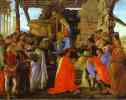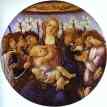Alessandro Botticelli Biography
Alessandro Botticelli was born in Florence in 1444 or 1445, the fourth son of Mariano di Vanni Filipepi, a tanner. Alessandro's nickname was derived from the one given to his eldest brother Giovanni, who, because of his corpulence, was called "Il Botticello" (little barrel). It is believed that Botticelli was apprenticed as a goldsmith before being sent, probably in the beginning of the 1460s, to Fra Filippo Lippi in order to study painting.
From 1470, Botticelli ran his own workshop in Florence and, in 1472, he became a member of the St. Luke's Guild. His early woks were mostly small religious pieces. In 1470, he was commissioned to paint Fortitude (c.1470) for the Florentine Tribunate di Mercatanzia. In 1474, his first monumental work St. Sebastian (1474) was mounted on a pillar in the Florentine church of Santa Maria Maggiore. He painted Adoration of the Magi (c.1475), on which he depicted members of Medici clan, the ruling family of the Florence, also his Portrait of Giuliano de' Medici (c.1476-1477) was well known. He had a lasting fame as a painter of Madonnas. Among his best are Madonna and Child with Eight Angels (Tondo Raczynski) (c.1478), Madonna del Libro (c.1480), Madonna of the Magnificat (c.1480-1481), Madonna of the Pomegranate (c.1487), Madonna del Padiglione (c.1493).
In 1480, Botticelli was commissioned to paint the fresco St. Augustine (1480) for the Ognissanti church. At that period he also created another fresco, which did not survived. In 1481, Botticelli was commissioned along with Domenico Ghirlandaio, Cosimo Rosseli and Pierro Perugino by Pope Sixtus IV to decorate his cappella magna, which was later named the Sistine Chapel after him, with frescos. He created The Temptation of Christ (1481-1482), Scenes from the Life of Moses (1481-1482) and The Punishment of Korah (1481-1482).
In the next years he painted The Story of Nastagio degli Onesti(1482-1483), a series of 4 frescos based on the novella in Boccaccio's Decameron for the decoration of the Pucci villa, and his most famous mythologic works Primavera (c.1482) and The Birth of Venus (c.1485). He created several great altarpieces for Florentine churches, such as Virgin and Child Enthroned between Saint John the Baptist and Saint John the Evangelist (Bardi altarpiece) (1484), Virgin and Child with Four Angels and Six Saints (San Barnabas altarpiece) (c.1487), Coronation of the Virgin with the Saints John the Evangelist, Augustine, Jerome and Eligius. (San Marco altarpiece) (c. 1490-1492).
In the 1490s, Botticelli became influenced by the Dominican monk Girolamo Savonarola, in whose sermons and writings he conjured up visions of the Apocalypse at the imminent turn of the century and warned people to repent and embrace asceticism. Botticelli's style became more severe and strict. In the late 1480s, the artist made illustrations for Dante's Divine Comedy. Among his last known works are Calumny of Apelles (c.1494-1495), The Story of Virginia (c.1496-1504), The Story of Lucretia (c.1496-1504), Mystic Nativity (1500) and St. Zenobiuspanels (1500-1505). The last years of Botticelli's life are unknown. He died on the 17th of May, 1510 in Florence and was buried in the Ognissanti cemetery.
Bibliography
Painting of Europe. XIII-XX centuries. Encyclopedic Dictionary. Moscow. Iskusstvo. 1999.
Botticelli. by V. Graszhenkov. Moscow. 1962.
Sandro Botticelli. by T. Kustodiyeva. Leningrad. 1971.
Sandro Botticelli. by G. Dunayev. Moscow. 1977.
Botticelli by Federico Zeri (Editor), Marco Dolcetta (Editor), Sandro Botticelli. NDE Publishing, 2000.
Sandro Botticelli: Life and Work by Ronald Lightbown. Abbeville Press, 1989.
The Painter's Daughter: The Story of Sandro Botticelli and Alessandra Lippi by Carolyn Street LaFond. Frederic C. Beil Publisher, 2002.
Sandro Botticelli: The Picture Cycle for Dante's Divine Comedy by Hein-Thomas Altcappenberg. Royal Academy Books, 2000.
Botticelli by Pierluigi De Vecchi, Daniel Arasse. Skira, 2004.
Sandro Botticelli 1444/45-1510 (Basic Art) by Taschen, Barbara Deimling. Taschen, 2000.
- Fortitude.

c.1470. Tempera on panel. Galleria degli Uffizi, Florence, Italy.
- St. Sebastian.

1474. Tempera on panel. Staatliche Museen Preubischer Kulturbesitz, Gemaldegalerie, Berlin, Germany. Read Note.
- Adoration Of The Magi.

c.1475. Tempera on panel. Galleria degli Uffizi, Florence, Italy. Read Note.
- Portrait Of Giuliano De' Medici.

c.1476-1477. Tempera on panel. National Gallery of Art, Washington, DC, USA. Read Note.
- Madonna And Child With Eight Angels (Tondo Raczynski).

c.1478. Tempera on panel. Staatliche Museen Preubischer Kulturbesitz, Gemaldegalerie, Berlin, Germany.